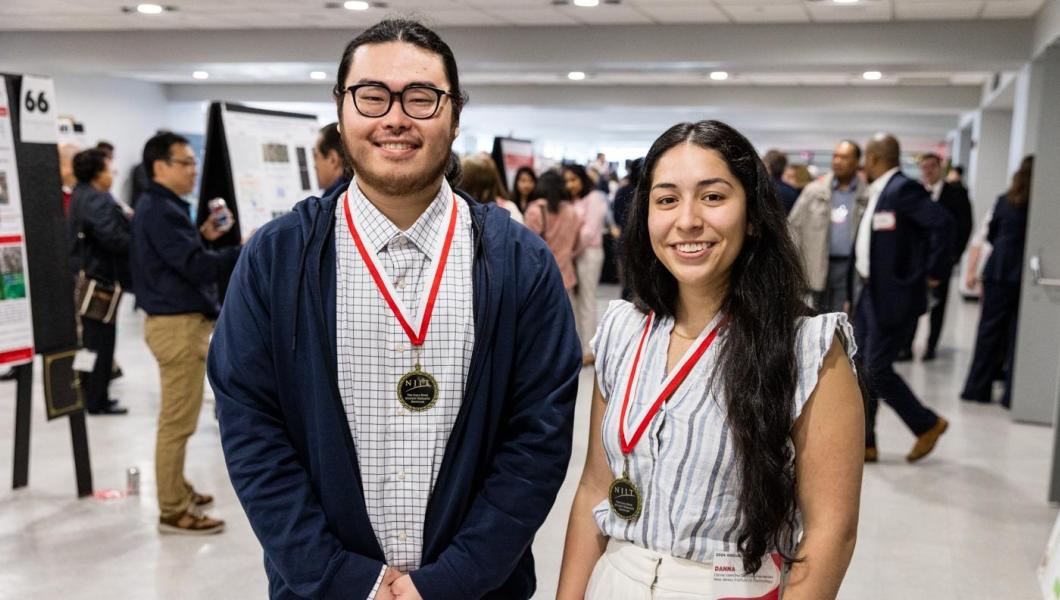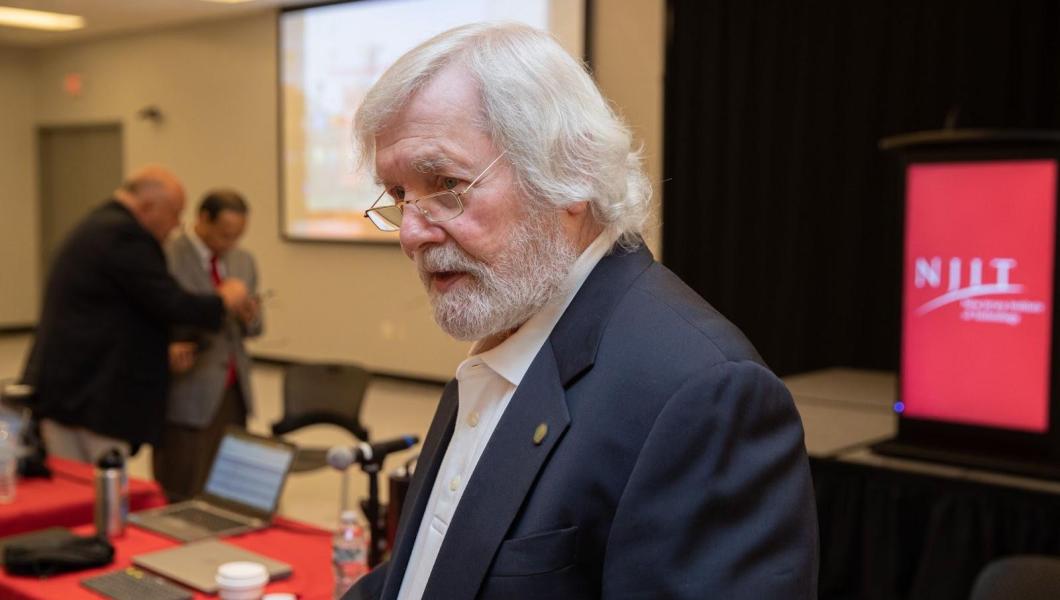Students Search for Insights into the Brain and Behavior

Learning is very much a hands-on experience for Nicole Andanar, Hannah Gattuso, Yasmine Ghattas and David Liptsyn, NJIT undergraduates enrolled in Albert Dorman Honors College who are working with Associate Professor Eric Fortune, Department of Biological Sciences, to explore the unknowns of how the brain uses sensory information to influence behavior. In Fortune’s Laboratory in the Central King Building, they’re advancing research that engages them, in a very personal way, with experiments involving fish that navigate by means of electric fields and birds that sing incredibly complex duets.
These students, in keeping with NJIT’s goal of offering every undergraduate opportunities for research, are immersed in what Fortune characterizes as a “hands-on, physical exploration of the world around us, with countless hours of work.” He adds, “We are physically examining unknown neurophysiological phenomena that are hidden in the brain. My students conduct experiments with me, often every day, in the laboratory to pursue these truths.”
In general, Fortune and his students are asking questions about how the brain makes computations based on input from different senses for the control of behavior. For example, how is information from our eyes integrated with information in myriad receptors in our skin and muscles when we walk down a flight of stairs? We have mathematical hypotheses that describe many of the computations that must go on in the brain, but we don’t understand how the brain implements those computations.
Although researching sensory integration and behavior presents complex challenges, there are animals with special characteristics that can help to increase knowledge in this area. This is why Fortune is working with weakly electric fish in the laboratory at NJIT and in the field in Ecuador, as well as with a species of wren native to the same South American country. It’s research that students working with Fortune have a direct and creative role in advancing, from designing new experiments, to building equipment that can’t be purchased “off the shelf,” to analyzing the wealth of data being gathered.
Asking Electric Questions
Andanar, Gattuso and Ghattas are focusing on electric fish. The electrosensory capabilities of these fish allow them to control complex behavior using only electricity, the “currency of the nervous system.” Because this control does not involve the intervening and complicating mechanics of systems like muscles, the fish are an important ally in determining how neural codes are integrated in the brain to control behavior.
Andanar, who looks forward to graduating in 2018, is a biochemistry major with a minor in environmental science and policy. Although medical school is a future possibility for her, she is considering taking a gap year to pursue a master’s. She is studying the evolutionary changes in electrosensory behavior of a species of weakly electric fish that invaded one dark underground cave in Brazil. These extremely unusual fish have, after many generations living within the cave, lost their sight. Andanar is studying the differences between the original “surface” species, which still have eyes, and the cave species that no longer can see. Andanar uses sophisticated analytical software to quantify data that was gathered in the field by Fortune and his colleague Assistant Professor of Biological Sciences Daphne Soares.
Andanar says, “We’re trying to determine if there are interactions between fish at specific electric frequencies, and how these interactions may differ between the cavefish and surface fish. We’re also trying to determine how the relative sizes of blind fish and the surface species affect the electric field, and how that may also impact the types of social interactions between fish.”
For Andanar, this experience has illuminated the realities of scientific discovery. She says that it has been a process that includes understanding the amount of time that must be dedicated to the effort and venturing beyond your academic comfort zone to accept that making mistakes is part of learning and growing as a researcher.
Gattuso, a biomedical engineering major who is embarking on her senior year, is working with a species commonly known as the brown ghost knife fish to understand how the fish process information about movement in brain circuits. Gattuso says that what she had learned about research opportunities available to undergraduates is a primary reason why she enrolled at NJIT, and her research experience at the university has involved both leading-edge lab experiments and assisting Fortune in the field in Ecuador.
On campus in the Central King Building, she has helped to record data directly from neurons in the midbrain of brown ghost knife fish. It’s experimental investigation that Fortune says is literally in the hands of the students, and Gattuso has become adept at inserting minute electrodes at the appropriate anatomical location in the fish, which requires making an opening that’s half a millimeter in diameter within a one-millimeter incision. “These are truly astounding microsurgeries,” Fortune says.
In addition to her skillful use of fine surgical tools, Gattuso works with a variety of data-acquisition and processing equipment, and sophisticated analytical programs. “It’s learning through problem-solving, learning that teaches ingenuity and critical thinking, and which really cements understanding of concepts that can only be discussed in a theoretical way outside of the laboratory,” Gattuso says. And she adds that the experience of hands-on research has challenged her to deal with the unexpected, the unexpected positive results that actual experiments can yield as well as problems that need to be solved to continue successful investigation.
Ghattas is a sophomore who came to NJIT from California, “quite a ways from home,” as she says. A chemistry and biology major, she is considering working toward MD and Ph.D. degrees after graduation. Support provided through the university’s Undergraduate Research and Innovation (URI) program has enabled her to pursue a research project that she designed related to weakly electric fish.
Ghattas’ project, “Feedback Control of Social Behavior,” involves acquiring and assessing sensory motor information. She explains, “What we’re doing is looking at how electrical feedback influences how the fish move. The first step is to record data about the movement of individual fish in the dark, when they rely on electrosensory cues, and in the light, when they can use their eyesight to navigate. Then we’re going to add conspecifics and to see how social context affects their movement. We’re going to see how the electrical signals from individual fish change when they interact with each other.”
Like Andanar and Gattuso, Ghattas enthusiastically endorses the hands-on research experience. “I can read about the behavior of these fish in a textbook, but it’s very different to learn about them in the lab. You can learn why they do what they do, and see how experiments can add to what we know about their behavior, and possibly make broad inferences about neural activity and social behavior. I think it’s pretty awesome.”
The Significance of Complex Singing

David Liptsyn is visualizing the complex cooperative singing behavior of plain-tailed wrens — research that could even enhance our understanding of related neurophysiological processes in humans.
David Liptsyn, a junior majoring in biology, is also thinking about medical school as a possibility after graduation. But as he works toward his undergraduate degree, he is pursuing research mentored by Associate Professor Fortune and with support from the university’s URI program. His project is entitled “Mathematical Modeling of Cooperative Singing Behavior in the Plain-Tailed Wren.”
This species, which Fortune and his students study in Ecuador, have a unique behavior that is useful for the study of how the brain coordinates complex cooperative activities — such as two people dancing together. In these wrens, males and females sing a duet that is so precisely and quickly timed that it can sound as if only one bird is singing.
The path that brought Liptsyn to this leading-edge of neuroscience began with his volunteering in Fortune’s lab as a freshman, starting by helping to maintain the lab’s fish tanks. Immersing himself in published literature, he moved on to assisting with analysis of birdsong data that Fortune had gathered in Ecuador — an effort that Gattuso helped with during summer months spent doing field research last year.
Liptsyn is now working independently to examine the complexities of how the nervous system codes for the wrens’ duetting behavior using the audio recordings from Ecuador. “Ideally, we will be able to create a mathematical model that will help us understand the neurophysiology that makes it possible for the birds to sing such duets. The goal is a model that can be used to test different hypotheses about how the birds vary their song and compare it to actual data.”
For Liptsyn, as for the other students mentored by Fortune, hands-on research and in-depth learning are synonymous. He says, “First, there’s the personal interaction with Professor Fortune. I get to ask a lot of questions that help me understand our work much more clearly. You also really understand the research process in general, how experiments should be done. Reading is not the same as understanding the process.”
For each of these students, learning continues to be a very hands-on experience, with encouragement to join faculty in the lab and in the field as colleagues, and to take advantage of opportunities for research of their own. As Yasmine Ghattas says, “No door is closed to you at NJIT.”

